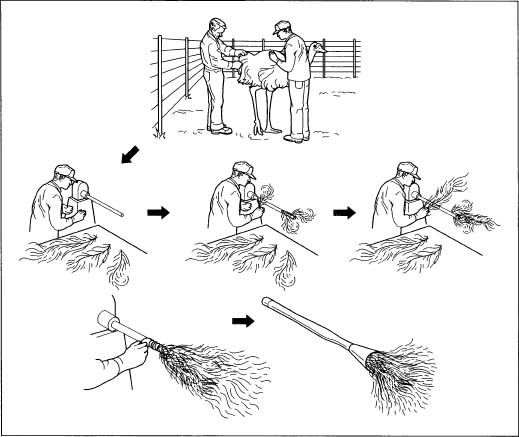HOW FEATHER DUSTERS ARE MADE
South Africa is virtually the only place where ostriches are farmed
for feathers and other products and where feather dusters are made.
Feather dusters sold in the United States and other countries under the
brand names of major manufacturers of home products are purchased
directly from South African wholesalers.
The plants in South Africa that make feather dusters both process
the feathers and assemble the dusters. Ostrich feathers are plucked
from live birds cared for on large farms of thousands of birds. These
farms also produce leather and meat from separate stocks of ostriches.
The birds have many layers of feathers for insulation that range in
size from very short to extravagantly long. The processing and assembly
plant receives the feathers in bulk shortly after they have been
plucked from the farmed birds.
Handles for feather dusters are either wood or plastic. Wooden
handles are also made in South Africa and are received at the feather
duster plant as finished products. Specialized suppliers use hardwood
from several species of South African trees. Cured wood is cut into
blocks of suitable lengths and dimensions and turned on lathes to shape
the handles. Holes are drilled in the tops of the handles so loops can
be added for hanging the feather dusters. After the handles are turned
and drilled, they are sanded in machines that sand in several stages
using finer and finer grades of sandpaper. Finally, the handles are
stained and varnished. After drying, they are packaged and shipped to
the feather duster plant.
Plastic handles are made of Marlex plastic and are injection-molded
at Asian plants. Other plastic parts include ferrules, the caps that
fit over the feathers where they join the handles, and the hanging
loops. Again, the feather duster maker receives these not as true raw
materials but as supplied parts.
Contact glue is purchased in bulk from a specialized glue
manufacturer. Contact glue is semi-sticky and is not designed to be the
only fixative that holds feathers on the handles. Low carbon steel wire
provides the strong binding. The sizes of wire are described in gauges
that are measures of the diameter of the wire. Feather dusters are made
with 16-gauge wire, a relatively fine size equaling 0.001 in (0.03 mm)
in diameter. A wire manufacturer ships the wire to the feather duster
factory on large reels or rolls.
Design
The design of feather dusters made with ostrich feathers is almost
unchanged since about 1900. Probably the biggest design change in their
history was the production of some lines of dusters with plastic
handles when plastic design improved rapidly after World War II. Some
plastic dusters are made in retractable designs with hollow handles
that slip down over the feathers. Feather duster manufacturers will
make design changes specifically for clients. These special orders are
made for companies like large janitorial services or suppliers.
Design changes are more frequent for less expensive dusters made
with turkey feathers. Usually, these feathers are dyed, and colors are
changed occasionally depending on popular decorator colors. Handles for
these dusters are modified in length and curvature to attempt to
interest more purchasers. Foam grips on the handles are an example of a
recent design change made to be both functional and eye-catching.
Interestingly, the care of ostriches is a "design change" that
manufacturers are beginning to practice. Ostrich feather products have
very little value compared to meat and leather from the birds; meat
production generates 200 times more income than feather-related
manufacture. Consequently, farmers and manufacturers who maintain
flocks of ostriches are learning how to improve feather production.
Ostrich care has changed little since ostrich farming began on a large
scale, also about 100 years ago. Typically, it takes 12-14 months for
an ostrich's feathers to grow enough so they can be harvested. If the
birds are given quality feed and improved attention at the farms, this
time can be reduced to two months and feather quality also improves.
Workers in the feather duster plant are now also paid far more than
South Africa's minimum wage, so they invest more care in the plucking
and processing of the feathers. Designs of actual dusters made with
ostrich feathers may be forced to change in the future if costs of
materials skyrocket.
The Manufacturing
Process
- At the ostrich farm, individual birds are herded into corral-like
pens where handlers pluck the birds to harvest the feathers. Feathers
are plucked from the bodies of the birds where the ideal types of
feathers (and those less likely to be damaged) grow but also from over
the birds' bodies so no single

The feathers are plucked from the ostrich and then applied to the handle.
area is denuded. When feathers are plucked from slaughtered
birds, damaged or heavily soiled feathers and types of feathers that
are not useful are avoided. After the best feathers are selected, the
remaining feathers are stripped off and destroyed before the hide is
removed for tanning and the meat is processed. - Plucked feathers are delivered in bulk to the factory. They are
washed, fumigated, graded by quality, and sorted by size. By the time
the feathers are ready to be delivered to the duster assembly stations,
they have been handled by at least 50 people.
- At each assembly station, about I oz (25 g) of feathers have been
sorted by size and are ready to be fixed to the handle. The handle is
held in a small, lathe-like device that the worker can turn as feathers
are fixed to the handle. Contact glue is spread on the bottom end of
the handle. The contact glue is not very sticky and does not dry with a
firm seal. It is only a temporary method of holding the feathers in
place until wire can be wrapped around them.
- After the first application of contact glue, the worker adds a
small layer of short feathers. More glue is spread, and a layer of
slightly longer feathers is put in place. The turning device keeps the
handle rotating, more glue is applied, and a layer of even longer
feathers is added. The process continues until all of the feathers
previously
sorted by length have been fixed to the duster handle.
- At each workstation, a roll of steel wire is mounted overhead above
the turning device. As the layers of feathers are added, the worker
wraps wire around the feathers already in place and ties and cuts the
wire. Wire is not used with each layer, but it is applied several times
during the process of building up the feather layers and after the last
layer is added.
- After the final feathers and wire are in place, a plastic cap
(ferrule) is pushed over the top of the feathers and wire. Covering the
wire makes the feather duster more attractive, but the cap also
prevents any wire ends from hurting the person who will use the duster.
A plastic cap is used with both wood and plastic handles. In fact, the
supplier packs a plastic cap with each handle so they are ready for
assembly. Loops for hanging the duster are tied through predrilled
holes or formed in the handles.
- Finished feather dusters are collected from the workstations and
taken to the packaging department. Plastic sleeves are fitted over the
feathers to cover them completely. The sleeves fit snugly but not too
tightly to hold the feathers in place but not break them, and the
sleeves are longer than the feathers so their tips do not get bent or
broken. Other wrappings are put over the handles. Feather dusters are
not packed and labeled for individual sale. Instead, they are packed in
bulk in cardboard shipping boxes for distribution to consumers who use
large numbers of feather dusters, like building maintenance firms and
supply houses for janitors. They are also shipped to retailers who may
change the packaging and add their own labels.
Quality Control
The handles, plastic ferrules, and hanging loops are inspected
before they are distributed to the assembly stations. The process of
controlling the quality of the feathers is continuous because the 50
people who handle the feathers during the cleaning, sorting, and sizing
steps are responsible for rejecting poor quality feathers.
Inspectors observe all stages of feather processing and duster
assembly. They intervene if they see inadequate materials or methods
that the worker overlooks. The inspectors also perform final
inspections of the finished feather dusters and look at each product
before it is boxed.
Byproducts/Waste
Production of feather dusters does not generate any byproducts
although feathers themselves are harvested during other processing of
products from ostriches, such as meat. Waste from the manufacture of
feather dusters consists mostly of feathers. Over 50% of those plucked
from live birds or saved from meat-producing stock are wasted because
of damage or poor quality. Feather waste is disposed by burning, which
is legal in South Africa. No wood or plastic waste is generated because
these components are made by outside suppliers and are not trimmed or
modified at the feather duster factory. There are also no metal
trimmings from the steel binding wire or wasted glue except for minor
spillage.
Employees are also exposed to few hazards. Safety guards and
emergency stops on the lathe-like turning devices prevent injury. The
steel wire is enclosed in a plastic cover until it is near the handle
that is being worked. The worker does not need to wear gloves to wind
the wire on the handle although goggles are worn for eye protection
because of the proximity of the wire. The glue is also inert and does
not present hazards due to fumes or skin contact. Dust from feather
processing is kept completely away from the duster floor, and, in the
feather-processing area, it is swept up frequently and collected for
burning with the other feather waste.(www.madehow.com)
 Facebook
Facebook Twitter
Twitter Contact Us
Contact Us


